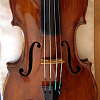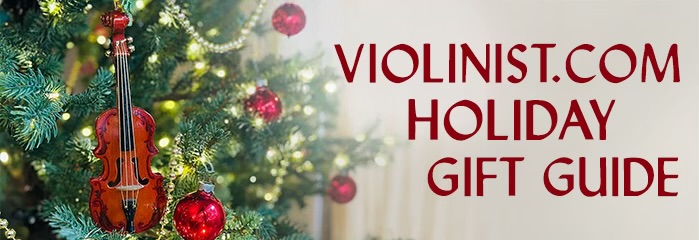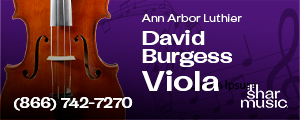
November 2014
V.com weekend vote: What kind of exercise goes along best with violin-playing?
November 21, 2014 15:04Everyone needs to exercise to promote good health, but what are the most effective forms of exercise for someone who regularly plays the violin?
Even if you've reduced your playing to the most ergonomically efficient and pain-free set of motions, playing the violin still sets us up for some unequal muscle-building. Add to that the stress of performing and the repetitive, solitary and possibly fairly sedentary nature of practice, and you're in trouble if you don't find a good form of exercise.
But what kind of exercise best helps even muscle tone, or reduce stress, or add that cardio-vascular element that is missing from long days of practice, teaching or performing?
I've listed a few below, but I'm sure I'm missing quite a few forms of good exercise and I invite you to list more. You may do several of these forms of exercise, but choose the one that you feel is doing the most for you, or tell us in the comments what exercise you prefer.

Running: Definitely good for endurance and cardio-vascular health. Related to running: Walking. Walking is so underrated, and yet it is a wonderful form of exercise. Take 10,000 steps a day, says the doctor!
Weight-lifting: For a long time I thought this was a bad idea because of the potential to overdevelop certain muscles. What changed my mind? David Garrett! Here is someone who is in great shape and does high-energy stadium shows on a regular basis. He said he is careful to target particular muscle groups and not to push too hard. Seems to work for him!
Yoga: This can help both build muscles and stretch muscles, and the controlled-breathing element can help with reducing stress in situations of pressure.
Swimming: A number of famous string players swore by this low-impact form of exercise, among them, Janos Starker. Great for the lung, and it doesn't stress the joints.
Please let us know your favorite form of exercise, and add your comments.
Tweet
V.com weekend vote: Have you sold a violin or bow at a profit? (not for dealers)
November 14, 2014 12:53Violins and bows are supposed to appreciate in value, and certainly that's the idea when investors plunk millions down for a Strad.
The tax man certainly won't depreciate your instrument, either.
 But what is the reality, when it comes to a violinist (not a dealer) trying to sell the typical violin and bow, at the student level and even at the moderately high end? Earlier this week, V.com member Rhoda Barfoot wrote about buying a second-hand violin and asserted that "Generally speaking, violins (or violas or cellos) are like almost any other purchase you make: except for certain professional instruments, they are most valuable when they are new and will not increase in value over time. This is especially true for beginner instruments."
But what is the reality, when it comes to a violinist (not a dealer) trying to sell the typical violin and bow, at the student level and even at the moderately high end? Earlier this week, V.com member Rhoda Barfoot wrote about buying a second-hand violin and asserted that "Generally speaking, violins (or violas or cellos) are like almost any other purchase you make: except for certain professional instruments, they are most valuable when they are new and will not increase in value over time. This is especially true for beginner instruments."
People took great exception to this idea of violins depreciating, and yet, I suspect it's true. Unless you are buying a violin that has documented antique or historical value, your fiddle or bow just may not fetch the same price that you bought it for, as much as you hoped it would.
For example, when a young student buys a fractional-size violin, usually they can turn it in for a fraction of its price, when they upgrade to a larger size. No profit there. Even if you buy a relatively high-priced fine instrument or bow and try to sell it after 10 years, you may not be able to sell it for as high as you bought it. In my own experience, I bought a high-end bow from a fine shop (complete with papers) and sold it years later at a loss, after speaking with many dealers in many cities and finding the one who could do his best for me on commission. I also bought a violin that I sold for the exact same amount I bought it for; I had to wait about a year to get the price. I've known parents who have struggled to sell their child's discarded instrument; usually they wind up donating it because the hassle of selling just isn't worth the money they would get.
I'm curious about people's real-world experience buying and selling, and not based on appraisals or what you theoretically should get if you were to sell something today. Some people have never tried to sell a violin. But among those who have bought and sold, did you sell your violin or bow at a loss or a profit?
Tweet
V.com weekend vote: What is your favorite movement of the Bach Double?
November 7, 2014 10:55I love the Bach Double, any movement.
I still remember being a student and trying to pick out the first movement of Bach's Concerto in D minor for Two Violins by ear, before I was ready to play it. Most violin students play the first movement at some point; I was not a Suzuki student but I studied both the Violin 1 and Violin 2 first-movement parts, which also appear in Suzuki Books 4 and 5. Once I could play one part, I was always happy to find someone who could play the other, so we could launch into a duet before rehearsal, etc. It's alway fun to instigate a spontaneous Bach Double!
 In the early days, that piece was a little hard to put together, and I can remember that getting to the end without a train wreck was a major victory. Many years later, after playing it with so many students on so many occasions, it's pretty solidly wired for me! But it never gets old, and I'm still game for the ride. Ask me to play that piece with you, I'll happily oblige.
In the early days, that piece was a little hard to put together, and I can remember that getting to the end without a train wreck was a major victory. Many years later, after playing it with so many students on so many occasions, it's pretty solidly wired for me! But it never gets old, and I'm still game for the ride. Ask me to play that piece with you, I'll happily oblige.
What's too bad is that not everyone plays all three movements! In fact, students are sometimes surprised to learn that there is more to it than that ubiquitous first movement. The second movement is one of the most beautiful slow movements written for violin(s), and the last movement is a rollicking ride. I have a few students studying the last movement now, and playing the duet with each (so that they can play it easily with each other) is one of the most enjoyable parts of my week!
Which movement do you most enjoy, in the Bach Double? You can answer from a playing standpoint, a wanting-to-play standpoint, or a listening standpoint.
I've put together some Youtubes for your listening pleasure, to help you vote:
1. Vivace
Here we have husband-and-wife team Gil Shaham and Adele Anthony, from SWINGING BACH 2000 Live from the Marketplace in Leipzig:
2. Largo, ma non tanto
This movement would be gorgeous played on any instrument, but I thought you might enjoy this period-instrument version with Carla Moore and Cynthia Miller Freivogel, solo baroque violins, with Voices of Music:
3. Vivace
Here's a performance with a lot of spark by sister-brother team Lara St. John and Scott St. John; they are playing with the New York Bach Ensemble:
* * *
And just for fun -- those Time for Three guys! Nick Kendall, Zach De Pue and Ranaan Meyer play their jazzed-up version of the Bach Double first movement:
Tweet
More entries: October 2014
Violinist.com is made possible by...
International Violin Competition of Indianapolis
Violinist.com Holiday Gift Guide
Dimitri Musafia, Master Maker of Violin and Viola Cases
Johnson String Instrument/Carriage House Violins
Subscribe
Laurie's Books
Discover the best of Violinist.com in these collections of editor Laurie Niles' exclusive interviews.

Violinist.com Interviews Volume 1, with introduction by Hilary Hahn

Violinist.com Interviews Volume 2, with introduction by Rachel Barton Pine






